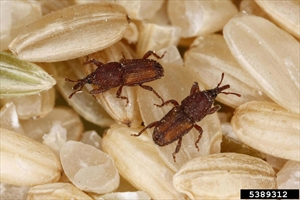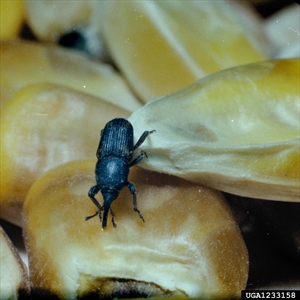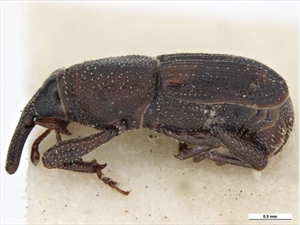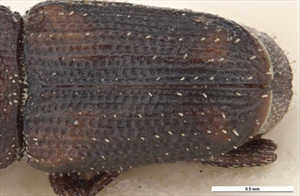Rice weevil, lesser grain weevil, small snout weevil
Pacific Pests, Pathogens, Weeds & Pesticides - Online edition
Pacific Pests, Pathogens, Weeds & Pesticides
Rice (lesser grain) weevil (338)
Sitophilus oryzae; a similar species (Sitophilus zeamais) attacks maize (see Fact Sheet no. 339).
Asia, Africa, North, Central and South America, the Caribbean, Europe, Oceania. It is recorded from Australia, Fiji1 and New Zealand. Because of previous taxonomic difficulties in distinguishing this weevil from Sitophilus zeamais, the reference to Sitophilus oryzae in Fiji needs confirmation.
Rice, maize, sorghum, wheat, and cassava. Both greater and lesser grain weevils attack cassava. The weevil also attack processed products, such as pasta. There is evidence (from Indonesia) that Sitophilus zeamais is more common on milled rice, and Sitophilus oryzae is more common on paddy (rice in the husk before processing). Sitiphilus oryzae is also common on wheat.
The adults attack sound grain, and both adults and larvae feed inside them, leaving large cavities and emergence holes (Photo 1). The adults also attack damaged grains (Photo 2). During large infestations, heat and moisture are produced, leading to colonisation by moulds and mites.
Females lay 300-400 eggs, singly, in holes chewed in the grains and covered with a gelatinous substance. On average, four eggs are laid a day for 4-5 months. The eggs hatch into white, legless larvae, which remain inside the grain, and pupate there. Adults are 3-4 mm long, reddish-brown to black (Photos 3&4), with four light-reddish to yellowish spots at the corners of the wing cases (Photo 5). At 30°C and 70% RH, the life cycle takes 25 days. Adults live for several months to a year.
The weevil is not a strong flyer, less so than Sitophilus zeamais, and spread to new locations is by adults and larvae on and inside consignments of grain.
The weevil is considered a very destructive pest of stored grain, rice, maize, barley and wheat. Attacks from Sitophillus oryzae can start in the field, when the moisture content is about 20% (although Sitophilus zeamais is the stronger flier and more likely to infest crops before harvest). Commonly, loss of weight is up to 5%, but severe infestations increase the losses up to 40%. Secondary damage is caused by moulds, insects and mites.
Look for the reddish to nearly black weevils, and holes in the grain. Look for the faint yellowish or reddish spots on the corners of the wing cases (Photo 4). The snout is long, about 1 mm. Note that identification of Sitophilus oryzae is difficult because of its similarity with Sitophilus zeamais, and needs to be done by a taxonomist. Males are said to produce a pheromone which is attractive to both Sitophilus oryzae and Sitophilus ziamais.
CULTURAL CONTROL
It is most important to dry the grain properly, to keep the storage area clean, and to monitor the grain often and regularly.
Before storage:
- Harvest maize as soon as it is mature.
- Dry the grain as soon as possible after harvest, and repeat during storage if necessary. Moisture levels should be about 12% (most stored product pests required moisture levels of 13-18% to reproduce).
- Keep grain storage rooms, sheds, houses, or 'cribs' clean. Remove old kernels, and sweep floors, walls, doors, and vents to collect seeds, grain powder and dust, and burn them before storing the new harvest.
- Collect and dispose of spilled grain in or around the storage area.
- If using bins, remove any grains that remain (and, if possible, spray with insecticide). If using sacks, do not reuse those that stored previous harvests.
- For small amounts, store maize, rice, wheat, etc. in plastic containers
During storage:
- If there is an infestation, locate the source by putting sticky traps around the room or warehouse where it occurred. Usually, the greater the number of weevils the nearer the source. Once located, destroy the infested grain by wrapping it in heavy plastic bags or in sealed containers, and burn or bury deeply in the soil. Note, toys can sometimes be filled with grain and act as a source of infestation; so too can dried flowers.
- For small infestations, freezing for several days and then heating for 24 hours is affective. Perhaps a method to avoid if seed is for growing.
- Sieving has been used as a method of removing adult weevils, but it is very labour intensive.
CHEMICAL CONTROL
If pesticides are needed, use the following:
Routine hygiene treatments
-
Malathion: apply to walls, floors, and inside of bins used to store the grain.
Treatment of seed for sowing
- Synthetic pyrethroids: e.g., deltamethrin or cypermethrin. Note care are must be taken to ensure that the treated seed does not contaminate that used for human consumption. It must not be used for animal consumption, poultry feed or mixed with animal feed.
- Neonicotinoids, e.g., imidacloprid. Similar cautions apply as for pyrethroids (above).
Treatment of grains for human consumption or for animal feed [make sure the product is labelled for use on rice, maize and small grains (barley, oats, wheat)]
- Pyrethrins: Used as a grain protectant (sometimes with piperonyl butoxide). Pyrethrins are manufactured from chrysanthemum flowers. There is a withholding period of 1 day before treated grain can be used for human or stock consumption.
- Malathion: (i) As a spray; treat grain and do not use for food within 90 days of treatment; (ii) as a dust; treat grain and do not use for food within 14 days of treatment. Note that many storage pests are resistant to malathion.
- Neem: The repellent effect of neem may keep grains free from infestations for several months.
- Bt: Some success has been reported using Bt, Bacillus thuringiensis.
- Beauveria bassiana: It is used against the weevil on maize.
-
Phosphine: Used as a fumigant; grain is covered by a tarpaulin or in other ways sealed for the duration of the fumigation. The procedure is carried out by certified operators.
ALWAYS CHECK WHETHER THE PRODUCT IS FOR TREATING EQUIPMENT, BINS AND BUILDINGS OR FOR TREATING GRAIN FOR HUMAN USE AND ANIMAL FEED. READ THE INSTRUCTIONS.
____________________
When using a pesticide, always wear protective clothing and follow the instructions on the product label, such as dosage, timing of application, and pre-harvest interval. Recommendations will vary with the crop and system of cultivation. Expert advice on the most appropriate pesticide to use should always be sought from local agricultural authorities.
AUTHOR Grahame Jackson
1Information from Swaine G (1971) Agricultural Zoology in Fiji. Her Majesty's Stationery Office. London; and CABI (2015) Sitophilus oryzae (lesser grain weevil). Crop Protection Compendium (https://www.cabi.org/cpc/datasheet/10887); and Rickman J, Gummert M (undated) Pest management in storage. IRRI. (http://www.knowledgebank.irri.org/search-results?gsquery=common+post+harvest+insects); and from DPI&RD (2019) Insect pests of stored grain. Agriculture and Food. Government of Western Australia. (https://www.agric.wa.gov.au/pest-insects/insect-pests-stored-grain). Photos 1&2 Clemson University - USDA Cooperative Extension Slide Series, Bugwood.org; Photos 3&4 Walker K (2006) rice weevil (Sitophilus oryzae): PaDIL - (http://www.padil.gov.au).
Produced with support from the Australian Centre for International Agricultural Research under project PC/2010/090: Strengthening integrated crop management research in the Pacific Islands in support of sustainable intensification of high-value crop production, implemented by the University of Queensland and the Secretariat of the Pacific Community.








